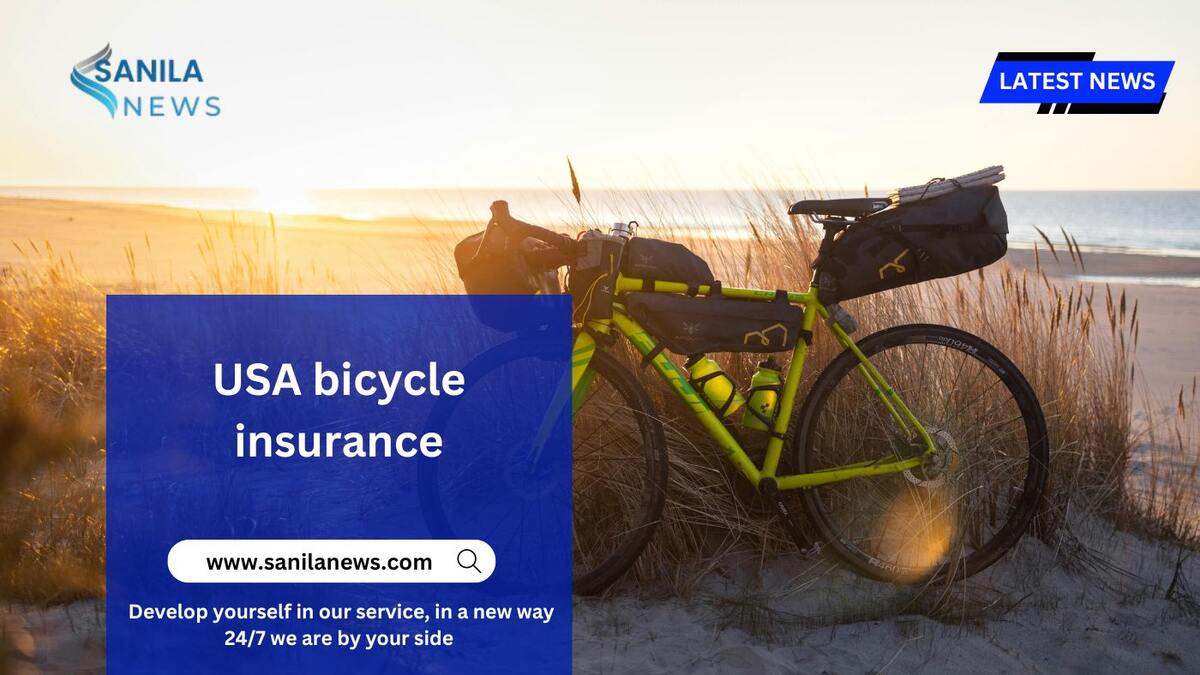A Comprehensive Guide to USA bicycle insurance
Cycling in the USA has grown in popularity over the years, not just as a mode of transportation but also as a sport and leisure activity. Whether you’re a commuter, a weekend warrior, or a competitive cyclist, protecting your investment in your bicycle and safeguarding yourself against potential risks is crucial. This is where bicycle insurance comes into play.
1. What is Bicycle Insurance?
Bicycle insurance is a specialized form of coverage designed to protect cyclists from the financial repercussions of accidents, theft, damage, and liability. Just as car insurance provides financial protection for drivers, bicycle insurance offers similar coverage for cyclists. Given the rising value of modern bicycles, which can range from a few hundred to several thousand dollars, having insurance can provide peace of mind and financial security.
While some homeowner’s or renter’s insurance policies may offer limited coverage for bicycles, standalone bicycle insurance policies typically provide more comprehensive protection tailored specifically for cyclists.
-
Why Do You Need USA bicycle insurance ?
There are several compelling reasons to consider bicycle insurance:
- High Value of Bicycles: Modern bicycles, especially those used for racing or serious commuting, can be very expensive. Replacing a stolen or damaged bike without insurance can be a significant financial burden.
- Theft: Bicycle theft is a common problem in many urban areas across the USA. Even with the best locks and security measures, bicycles are still vulnerable to theft.
- Accidents and Injuries: Whether you’re cycling in the city, on a trail, or competing in a race, accidents can happen. Bicycle insurance can cover medical expenses, liability, and damages resulting from collisions.
- Damage: Bicycles can be damaged in various ways, from collisions with vehicles to accidents involving potholes or debris. Insurance can cover repair costs, ensuring that your bike is back in working order quickly.
- Traveling with Your Bike: If you frequently travel with your bike, whether domestically or internationally, insurance can provide coverage against loss or damage during transit.
- Racing and Competitions: If you participate in races or competitions, specialized insurance can cover your bike against damage or theft during these events.
3. Types of USA bicycle insurance Coverage
Bicycle insurance policies can vary significantly, but most offer a range of coverage options that can be tailored to meet your specific needs. Here are the most common types of coverage available:
- Theft Coverage: This is one of the most important aspects of bicycle insurance. It covers the cost of replacing your bike if it’s stolen. Policies may require that your bike was secured with a lock at the time of theft and may have different coverage limits based on where the theft occurred (e.g., at home vs. in a public place).
- Accidental Damage: This coverage pays for repairs or replacement if your bike is damaged in an accident. This could include collisions with vehicles, crashes, or even damage from hitting a pothole or other road hazards.
- Third-Party Liability: If you are involved in an accident that causes injury to another person or damage to someone else’s property, this coverage can protect you from legal and financial liabilities. This is especially important for cyclists who frequently ride in busy urban areas.
- Personal Injury Coverage: If you are injured in a cycling accident, this coverage can help pay for medical expenses, rehabilitation, and lost income if you’re unable to work.
- Equipment and Accessories Coverage: Many cyclists invest in additional gear such as helmets, GPS devices, lights, and cycling computers. This coverage protects your equipment and accessories if they are stolen or damaged.
- Racing Coverage: For competitive cyclists, some policies offer coverage that specifically protects your bike during races, including events where your bike might be more prone to damage.
- Worldwide Coverage: If you frequently travel with your bike, look for a policy that offers worldwide coverage, ensuring that your bike is protected no matter where you ride.
- Replacement Cost vs. Actual Cash Value: Some policies offer replacement cost coverage, meaning the insurer will pay to replace your bike with a new one of similar make and model, rather than only paying the depreciated value.
-
Standalone Bicycle Insurance vs. Homeowner’s/Renter’s Insurance
USA bicycle insurance Many cyclists wonder whether they need standalone bicycle insurance or if their existing homeowner’s or renter’s insurance policy is sufficient. While homeowner’s and renter’s insurance can offer some coverage for bicycles, there are significant differences worth considering:
- Coverage Limits: Homeowner’s and renter’s policies often have lower coverage limits for bicycles, especially high-value bikes. Standalone bicycle insurance typically offers higher limits and can be adjusted to match the value of your bike.
- Deductibles: The deductible on a homeowner’s or renter’s policy can be higher than what you’d prefer for a bicycle claim. Standalone bicycle insurance usually allows for a lower, more manageable deductible.
- Claim Impact: Filing a bicycle-related claim under your homeowner’s insurance may affect your policy’s overall premiums or lead to a rate increase. A standalone policy keeps bicycle claims separate from your home insurance.
- Specialized Coverage: Standalone bicycle insurance offers coverage options specifically tailored to cyclists, such as racing coverage, event coverage, and coverage for accessories and equipment. These specialized coverages are often not included in homeowner’s or renter’s policies.
- Global Coverage: If you frequently travel with your bike, standalone bicycle insurance can offer worldwide coverage, ensuring your bike is protected no matter where you are. Homeowner’s policies may limit coverage to domestic travel.
-
Factors Influencing USA bicycle insurance Premiums
Several factors influence the cost of bicycle insurance. Understanding these factors can help you make informed decisions when choosing coverage:
- Value of the Bicycle: The more expensive your bicycle, the higher the premium. Insurers will often ask for a purchase receipt or an appraisal to determine the value of the bike.
- Type of Bicycle: High-performance bicycles, such as those used for racing or mountain biking, may have higher premiums due to the increased risk of damage or theft.
- Location: Where you live plays a significant role in determining your premium. Urban areas with higher rates of bicycle theft typically have higher insurance costs. Additionally, some regions may have more challenging riding conditions, which could affect premiums.
- Security Measures: Insurers often provide discounts for cyclists who use high-quality locks, store their bikes in secure locations, or have bike alarms. Providing proof of these security measures can reduce your premium.
- Riding Habits: How often and where you ride can impact your insurance cost. Commuters who ride daily in urban environments may pay more than casual weekend riders due to the higher risk of accidents and theft.
- Claims History: Your history of insurance claims can influence your premium. A history of frequent claims may lead to higher rates, while a clean record can help keep costs down.
- Deductible Amount: Choosing a higher deductible can lower your premium, but it also means you’ll pay more out-of-pocket if you need to file a claim. Balancing the deductible with the premium is important for finding the right policy.
-
Local Considerations for USA bicycle insurance
Cyclists across the USA face different risks and challenges based on their location. Here’s how some regional factors might influence your bicycle insurance needs:
- Urban Areas: In cities like New York, San Francisco, and Chicago, bicycle theft is a significant concern. High-quality locks, secure storage, and comprehensive theft coverage are essential in these environments. Additionally, heavy traffic increases the risk of accidents, making liability and personal injury coverage important.
- Suburban Areas: Suburban cyclists may face less risk of theft but could be more prone to accidents involving vehicles, particularly on busy roads without dedicated bike lanes. Coverage for accidental damage and third-party liability is crucial in these areas.
- Rural Areas: In rural regions, cyclists may encounter less traffic but might face challenges like poor road conditions, wildlife, or long distances from medical facilities. Comprehensive coverage, including medical payments and equipment protection, is important.
- Coastal Areas: In regions prone to natural disasters, such as hurricanes or flooding, cyclists should consider coverage that protects against weather-related damage. This is especially relevant for those living near the coast or in areas with extreme weather patterns.
- Mountain and Trail Biking: Cyclists who frequently ride off-road or on mountain trails should look for policies that cover damage from rugged terrain and offer protection during events or races. Coverage for specialized equipment is also important for mountain bikers.
7. Finding the Best Bicycle Insurance Policy
USA bicycle insurance Choosing the right bicycle insurance policy involves careful consideration of your specific needs, the value of your bike, and your riding habits. Here are some tips for finding the best policy:
- Assess Your Coverage Needs: Start by determining the value of your bike and any additional gear you want to cover. Consider your riding habits, including how often you ride, where you ride, and whether you participate in races or events. This will help you identify the type and amount of coverage you need.
- Compare Policies: Shop around and compare policies from different insurers. Look at the coverage options, exclusions, deductibles, and premiums to find a policy that offers the best balance of protection and cost.
- Check for Discounts: Many insurers offer discounts for safety measures, such as using high-quality locks, storing your bike in a secure location, or having a clean riding record. Ask about any available discounts that could lower your premium.
- Read the Fine Print: Carefully review the policy terms and conditions, including any exclusions or limitations. Make sure you understand what is and isn’t covered, and clarify any questions with the insurer before purchasing.
Last word
Keep an eye on our news channel Sanila News to get updated news regularly.

